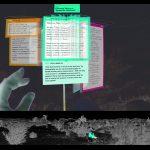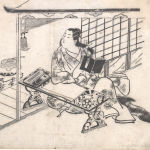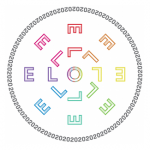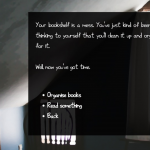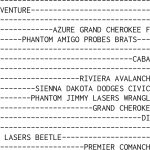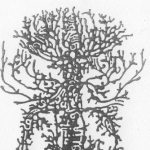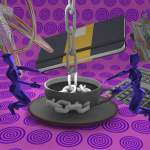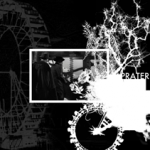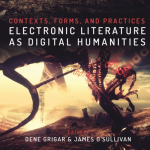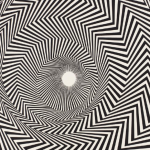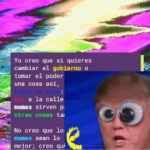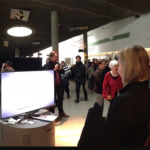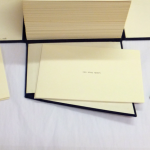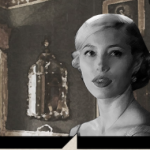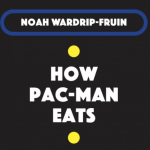2021
In this article, Kelsey Cameron and Jessica FitzPatrick propose attunement, a conceptual intervention that returns lived experience to critical making. They argue for attunement in three areas: disciplinary recognition of making, labs and other university maker spaces, and campus-community engagement. Attunement helps bring equity into critical making, highlighting how larger systems shape individual acts of making.
FEATURED ARTIST: In this essay, Caitlin Fisher reflects on the ideas, processes, and approaches that have shaped and influenced her work in digital storytelling and electronic literature for over 25 years. She invokes theorists like Borges, Haraway, and Aristotle and critical concepts of hybridity, string theory, hypermedia, and spatial narratives to illuminate readers about the simultaneous timelines, continuity, and forking paths that run through the river of her work.
Burdick situates the speculative software prototypes of Trina: A Design Fiction as design-theory hybrids that can expand our understanding of critical making and critical design. The essay offers four readings of the Trina prototypes, designed as research into speculative writing technologies that are situated and embodied. The essay concludes with the introduction of an “Indexical Reader,” a design concept for close and distant reading in the Humanities.
Wright explores the digital manifestation of an orihon manuscript style for how it can expand how we think of the novel's form. He considers how digital versions of J.M. Coetzee's Diary of a Bad Year and his own print novella make use of the concept of the fold as identified in the orihon style.
Stanfill and Salter reflect on conferencing amidst their organization of the 2020 ELO Conference in Orlando, Florida that had to change to due a global pandemic. Sharing their experiences and wisdom, they discuss the strengths and weaknesses of various virtual platforms for conferencing, coupled with the contexts of concurrent politics, co-location, and lessons for the future.
This except from Twining: Critical and Creative Approaches to Hypertext Narratives explores the popular and open-source digital storytelling platform Twine. Authors Anastasia Salter and Stuart Moulthrop discuss the history of Twine as well as existing works and possible projects.
Nick Montfort discusses two of his computer-generated texts that manifest as print-on-demand books, websites and gallery installations. Though distinct in form and content, Autopia and The Truelist were guided by the author's self-imposed constraints and programmed with minimal code to produce predetermined, "novel-size" outputs. Montfort intends these texts to engage the imaginations of readers with the combinatory aspects of language in culture as well as invite them to a deeper reading of the generating code.
Renren Yang insightfully reveals the rarely (if ever) explored domain of cover designs for Chinese Web novels. Tracing their evolution from a print format that enables the tactile and sensual pleasures of opening the actual book to its supposedly more immaterial digital incarnation, Yang reimagines the very idea of a book cover in the digital age. This closer look reveals how serialized novels’ cover design frames the reader's experience, demonstrating as well the fact that the already well established periodization of the First, Second, and Third Generation e-literature are culturally and geographically specific, and dependent on the local histories of computing technology beyond Euro-American context. Analyzing the conceptual tension and fusion between book cover as a “mixed medium” and digital cover as “intermedium,” and drawing upon Chinese pictorial tradition, Yang defines the ontology of the digital book cover as an attempt at reconfiguring “flatness” on the digital screen.
This essay engages with the complex translation of materiality that occurs between Darren Wershler’s NICHOLODEON (1997) and its eventual digital incarnation as NICHOLODEONLINE (1998). Both of these works pay homage to the influential avant-garde Canadian poet, bpNichol. Beyond situating Wershler’s texts in a historical framework that moves from Nichol to the 'Pataphysics of Alfred Jarry, Sean Braune looks at select metadata “clues” that Wershler left behind for the curious-minded reader (human and machine), as well as placing Wershler’s work (and Nichol’s by extension) in the context of theories of language that move from the human to the “tower of programming languages” that are described by Rita Raley and Friedrich Kittler.
MLA Chernoff closely examines Rachel Zolf's intentionally unreadable suite of transmedial poetry, Human Resources (2007), in order to discern a digital poetics of appropriation that carefully grapples with the problematics of historically exclusionary institutions like conceptual poetry and CanLit. They argue that behind the constraint-based, numerological practices used to create these strange poems lies a pragmatic – yet metaphysically-grounded – method of reframing the professionalization of creative writing and upending the neoliberal conventions of governmental grants.
Alois Sieben investigates how Jordan Abel’s Injun experiments—poetically, visually, digitally—with an anxiety-provoking limit to the settler-colonial gaze, rather than feeding this gaze a new representation of Indigeneity. Abel’s work is positioned within David Garneau’s history of Indigenous screen objects, in which something is held back from the settler-colonial gaze, a form of deprivation that exposes the blind hunger of this gaze, turning it back upon itself.
Carl Watts argues that J.R. Carpenter’s Entre Ville constructs Canadian literature as a unified, holistically understood entity that is both broadly accessible and fleetingly familiar. In so doing, Carpenter’s work aligns representations of Montréal with uses of new media, with the cross-cutting and mutually exclusive identities of the former mirrored in new-media poetry’s partial or conditional embrace of the formal possibilities of digital poetry.
88 Constellations for Wittgenstein (To be Played with the Left Hand) (2008) by Canadian artist David Clark is a web-based Flash creation that explores the life and works of Austrian-born philosopher Ludwig Wittgenstein. In this paper, we show how rhetoric and digital technologies join to visually express philosophical concepts. The idea of “visual music” has been previously addressed in various fine arts such as literature, film, painting, sculpture, and music itself. We argue that in electronic literature it is possible to explore this concept by means of what we propose to call “gestural melodic manipulation”, which is the interplay of semiotic units (e.g. videos, sounds, images, linguistic texts) that the reader can add to the narrative by means of interaction and manipulation. In Clark’s e-lit work, “visual music” triggers the literary characteristics of the text by exposing different discourses and diverse thematic through intertextual and intermedial practices.
Electronic Literature as Digital Humanities: Contexts, Forms & Practices is a volume of essays co-edited by Dene Grigar and James O’Sullivan that provides a detailed account of born-digital literature by artists and scholars who have contributed to its birth and evolution. Rather than offering a prescriptive definition of electronic literature, this book takes an ontological approach through descriptive exploration, treating electronic literature from the perspective of the digital humanities (DH)––that is, as an area of scholarship and practice that exists at the juncture between the literary and the algorithmic.
Thinking about the ways in which critical infrastructure studies can allow us to engage in antiracism critiques and practices, Ryan Ikeda provocatively challenges the electronic literature community to address some of the symbolic and material structures that he argues uphold the field. To this end, Ikeda positions elit infrastructure as dynamic and generative sites of cultural activity, and attends, in particular to the ELMCIP Knowledge Base, recent ebr discourses on decolonization, ELO fellowships, and literary historical genealogies, to examine how each constructs, affirms, racializes and extends power, privilege, and status to its members.
Claudia Kozak evaluates the potential of experimental e-lit to build decolonial critical paths within global digital humanities. Framing her perspective in the Epistemologies of the South (Sousa Santos) and decolonial thinking (Mignolo), she draws attention to politics of knowledge and analyses issues such as linguistic hegemonies, e-lit imaginaries and genealogies emerging from the Souths and unexpected mixtures between experimentalism and third-generation e-lit in Latin America.
2020
Søren Pold takes up the task to deconstruct the present cultural moment when the effects and ways of operating of social systems, as discussed by Johanna Drucker in her recent book, are becoming central interfaces to a broad range of lived reality. Pold’s offers a valuable effort at understanding the complex mechanisms of production of such systems via investigation of rhetorical and software aspects of networked media. With the focus on artistic research installation, The Oracle of Selphie by Jakob Fredslund and Malthe Stauning Erslev in collaboration with Pold and coupled with his own installation platform The Poetry Machine, Pold interrogates to what extent Drucker’s arguments allows for a critical approach to reading patterns in social media. Doing so, he simultaneously offers models of distracted reading grounded in the propositions by Michel de Certeau, Siegfried Kracauer, Walter Benjamin, and Olga Goriunova, demonstrating that “lurking” and other forms of inattentive reading can be exploited and turned into profit in the age of the platform capitalism. Such an observation calls for further research that would better grasp the nature of networked reading practices enabled (and more often forced) by our contemporary social media platforms.
Presenting the writerly and highly remixable analog edition as both pre- and proto-digital, Carly Schnitzler revisits Robert Grenier’s Sentences. She compares the analog version of “shuffle literature” (in choosing the term, she follows the footsteps of Nick Monfort and Zuzana Husarova), published as five hundred index cards stored in a box, with its 2003 digitized edition. Such comparison serves to set the ground to investigate further the potential for writerly literary forms of what Lawrence Lessig once described as Read/Write culture, beyond the analog/digital dichotomy. The detailed and attentive analysis proposed by Schnitzler leads to somewhat surprising conclusions, where the algorithmically driven automatic choices present far less potential for meaningful and open-ended interaction with the text. Simultaneously, all the nuances surrounding the relatively early efforts at rendering Sentences as an object of networked reading are demonstrated here, including hints on digitization as a practice with its own history.
How do we think about things — like electronic literature — that combine the operational aspects of computing systems with the affective and representational aspects of the arts? We could view them through the frameworks of computer science, the literary arts, or critical interpretation. These can all be valuable. But they are all, inevitably, partial. Wardrip-Fruin proposes that digital humanities frameworks can provide a way of thinking about the dual elements of electronic literature simultaneously. Here he provides a case study: a strand of research that is both in computational approaches to social simulation and in the creation of works that build upon, and guide the development of, these simulations. He discusses the digital humanities concepts of operational logics and playable models that help him and his collaborators understand their work as they carry it out.
What is the connection between how computer games work and what they mean? What do we do with games and what do they do to us? In its exploration of these questions, Stuart Moulthrop sees Noah Wardrip-Fruin’s How Pac-Man Eats (MIT Press, 2020) as helping to urge game studies in a productive new direction: one that critically traces interactions between games and the broader culture in which they're embedded. More specifically, he observes some of the ways Wardrip-Fruin’s work links “technē to social purpose”, and thereby “re-engages questions of value and justice”. This, he contends, is part of what distinguishes this author—"a scientist who is also a socially aware literary writer", as he approvingly puts it—from many of the “anatomists” with whom he founded this developing field.


